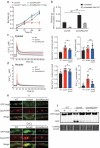Calcineurin-mediated intracellular organelle calcium homeostasis is required for the survival of fungal pathogens upon extracellular calcium stimuli
- PMID: 33843471
- PMCID: PMC8043181
- DOI: 10.1080/21505594.2021.1909954
Calcineurin-mediated intracellular organelle calcium homeostasis is required for the survival of fungal pathogens upon extracellular calcium stimuli
Abstract
In eukaryotes, calcium not only is an essential mineral nutrient but also serves as an intracellular second messenger that is necessary for many physiological processes. Previous studies showed that the protein phosphatase-calcineurin protects fungi from toxicity caused by the extracellular calcium; however, little is known about how calcineurin mediates the cellular physiology process for this function. In this study, by monitoring intracellular calcium, particularly by tracking vacuolar calcium dynamics in living cells through a novel procedure using modified aequorin, we found that calcineurin dysfunction systematically caused abnormal intracellular calcium homeostasis in cytosol, mitochondria, and vacuole, leading to drastic autophagy, global organelle fragmentation accompanied with the increased expression of cell death-related enzymes, and cell death upon extracellular calcium stimuli. Notably, all detectable defective phenotypes seen with calcineurin mutants can be significantly suppressed by alleviating a cytosolic calcium overload or increasing vacuolar calcium storage capacity, suggesting toxicity of exogenous calcium to calcineurin mutants is tightly associated with abnormal cytosolic calcium accumulation and vacuolar calcium storage capacity deficiency. Our findings provide insights into how the original recognized antifungal drug target-calcineurin regulates intracellular calcium homeostasis for cell survival and may have important implications for antifungal therapy and clinical drug administration.
Keywords: Fungi; aspergillus fumigatus; autophagy; calcineurin; calcium homeostasis; pathogenic fungi.
Conflict of interest statement
No potential conflict of interest was reported by the authors.
Figures







Similar articles
-
Calcineurin and Calcium Channel CchA Coordinate the Salt Stress Response by Regulating Cytoplasmic Ca2+ Homeostasis in Aspergillus nidulans.Appl Environ Microbiol. 2016 May 16;82(11):3420-3430. doi: 10.1128/AEM.00330-16. Print 2016 Jun 1. Appl Environ Microbiol. 2016. PMID: 27037124 Free PMC article.
-
Antifungal activity of amiodarone is mediated by disruption of calcium homeostasis.J Biol Chem. 2003 Aug 1;278(31):28831-9. doi: 10.1074/jbc.M303300200. Epub 2003 May 16. J Biol Chem. 2003. PMID: 12754197
-
The Lectin Chaperone Calnexin Is Involved in the Endoplasmic Reticulum Stress Response by Regulating Ca2+ Homeostasis in Aspergillus nidulans.Appl Environ Microbiol. 2017 Jul 17;83(15):e00673-17. doi: 10.1128/AEM.00673-17. Print 2017 Aug 1. Appl Environ Microbiol. 2017. PMID: 28550061 Free PMC article.
-
Components of the calcium-calcineurin signaling pathway in fungal cells and their potential as antifungal targets.Eukaryot Cell. 2015 Apr;14(4):324-34. doi: 10.1128/EC.00271-14. Epub 2015 Jan 30. Eukaryot Cell. 2015. PMID: 25636321 Free PMC article. Review.
-
Good fungi gone bad: the corruption of calcineurin.Bioessays. 2002 Oct;24(10):894-903. doi: 10.1002/bies.10157. Bioessays. 2002. PMID: 12325122 Review.
Cited by
-
Potential Antifungal Targets for Aspergillus sp. from the Calcineurin and Heat Shock Protein Pathways.Int J Mol Sci. 2022 Oct 19;23(20):12543. doi: 10.3390/ijms232012543. Int J Mol Sci. 2022. PMID: 36293395 Free PMC article. Review.
-
TRPML1 ion channel promotes HepaRG cell differentiation under simulated microgravity conditions.NPJ Microgravity. 2025 Mar 15;11(1):9. doi: 10.1038/s41526-025-00461-4. NPJ Microgravity. 2025. PMID: 40089547 Free PMC article.
-
Synergistic Antifungal Effect of a Combination of Iron Deficiency and Calcium Supplementation.Microbiol Spectr. 2022 Jun 29;10(3):e0112122. doi: 10.1128/spectrum.01121-22. Epub 2022 Jun 8. Microbiol Spectr. 2022. PMID: 35674440 Free PMC article.
-
Marine-Derived Metabolites Act as Promising Antifungal Agents.Mar Drugs. 2024 Apr 17;22(4):180. doi: 10.3390/md22040180. Mar Drugs. 2024. PMID: 38667797 Free PMC article. Review.
-
Transcription factors SltA and CrzA reversely regulate calcium homeostasis under calcium-limited conditions.Appl Environ Microbiol. 2023 Nov 29;89(11):e0117023. doi: 10.1128/aem.01170-23. Epub 2023 Oct 24. Appl Environ Microbiol. 2023. PMID: 37874299 Free PMC article.
References
-
- Islam MS. Calcium signaling: from basic to bedside. Adv Exp Med Biol. 2020;1131:1–6. - PubMed
-
- Rosendo-Pineda MJ, Moreno CM, Vaca L. Role of ion channels during cell division. Cell Calcium. 2020;91:102258. - PubMed
-
- Carafoli E. Intracellular calcium homeostasis. Annu Rev Biochem. 1987;56(1):395–433. - PubMed
-
- Blatzer M, Latge JP. Metal-homeostasis in the pathobiology of the opportunistic human fungal pathogen Aspergillus fumigatus. Cur Opin Microbiol. 2017;40: 152–159. - PubMed
Publication types
MeSH terms
Substances
LinkOut - more resources
Full Text Sources
Other Literature Sources
Medical
